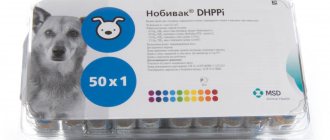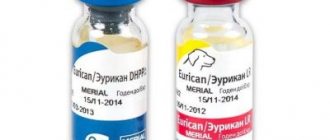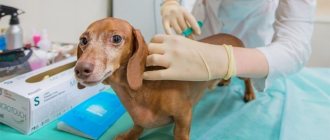The decision to have a pet comes with a lot of responsibility. It is necessary not only to provide the animal with fresh and high-quality food in a timely manner, to take walks, and to give physical exercise, but also not to forget about its health and to prevent the risks of diseases.
To protect your pet from such serious and life-threatening diseases as rabies, it is necessary to carry out annual vaccination, which will build immunity to external infectious agents.
What is rabies in dogs
Rabies is otherwise interpreted as a fear of water. It belongs to the category of deadly diseases. The source of the disease is a neurotropic virus belonging to the rhabdovirus family. First of all, the organs of the central nervous system are affected without the possibility of starting recovery processes. Rabies is caused by sick animals spreading the virus through interaction with healthy dogs. Such animals include birds, cats, dogs, and predators.
Incubation can last from several days to 2–4 months; the virus in saliva is detected 5–6 days before the first symptoms of rabies appear.
Infection occurs during a bite through the mucous membranes. As a rule, the virus is formed in the salivary glands. A small part of it is also excreted in urine and feces. The virus, penetrating the body, not only travels through the blood, but also involves nerve endings and affects the spinal cord and brain.
The virus tolerates frost well, but dies at temperatures above 56 degrees Celsius within 15–20 minutes. Direct sunlight, standard disinfectants, and alcohol also help fight the virus. But! Resistant to phenols, does not die during processing.
Due to the increased degree of preservation of the virus, it is constantly in the environment and causes harm to unvaccinated dogs and other animals. There are rumors that after eating contaminated meat, a dog can catch the virus, but this has not yet been confirmed in scientific studies.
Once a year, get a comprehensive vaccination that will protect your dog from contracting rabies and other life-threatening diseases.
Main signs of infection:
- Anxiety, excitability, partial fear of the sounds of water;
- Gradual refusal of water, the appearance of aggression towards people and other animals;
- The appearance of foamy saliva from the mouth, as muscle paralysis prevents swallowing;
- Desire to eat inedible things.
If you notice similar symptoms in your pet, you should immediately isolate it in a separate room and call a veterinarian to determine the diagnosis and provide first aid. Such a dog can harm people who are in the room.
For humans, this disease is also fatal, so you should be wary of stray dog bites, since they are unlikely to have a rabies injection. There have been cases when a successful cure occurred when a person was immersed in a very deep coma.
But this method is unsafe, as it can cause the development of severe mental disorders.
Forms of rabies stage
Rabies is characterized by acute and hyperacute forms. The infection itself develops in the following stages:
- Prodromal – duration is 48–72 hours, characterized by changes in the pet’s behavior, the appearance of anxiety and inadequate reaction to stimuli, the desire to hide in a secluded place and hide from all people, or, conversely, an increased demand for attention appears. Possible aggression;
- Manic – the pet’s mood is constantly changing, aggression can turn into apathy in a few minutes, interest in following commands is lost, and disobedience begins. Foamy salivation appears, aggression towards people and other animals is noticed. The dog is capable of running away from home;
- Paralytic or silent - severe apathy appears, paralysis of the muscles of the pharynx and hind limbs develops, the tongue begins to fall out, appetite disappears due to pain in the larynx, breathing and heart rhythm are disturbed. After a few days, the dog falls into a coma and dies from exhaustion and irreversible processes in the body.
Other stages of rabies are possible:
- Atypical - a characteristic sign is the appearance of gastroenteritis, accompanied by refusal of food, foamy vomiting with blood, diarrhea;
- Abortive (in bitches);
- Recurrent - at first the symptoms disappear, then reappear after a few days.
In order not to die, you need to know everything about rabies
In order for you to find out the answers to all your questions, you will have to dive deeper into the topic. Well-known veterinary medicine (veterinary medicine) is an area of scientific knowledge and practical activity aimed not only at combating animal diseases, but also at protecting people from zooanthroponoses , producing sanitary-quality animal products and solving veterinary and sanitary problems of environmental protection.
Zooanthroponoses are diseases common to animals and people, in which the source of pathogens for humans is our little brothers. That's why…
The main goal of combating the rabies virus among animals is primarily to protect people!
Vaccines for dogs against rabies
Mandatory vaccination is established at the state level. Without a note in the dog's passport about vaccination, it is impossible to participate in exhibitions. And also, customs does not allow such animals through; they can forcibly confiscate them and vaccinate them.
In some countries, there is criminal liability for failure to vaccinate animals. This is taken very seriously all over the world; you should not vaccinate your animal on time to protect yourself and save the life of your pet.
The following types of vaccines are used in the Russian Federation:
- Nobivak Rabies is a Dutch-made product that belongs to the category of those that do not contain a live pathogen. Its uniqueness lies in the possibility of using the vaccine as a solvent for other Nobivak vaccinations, which makes it possible to immediately protect the animal from several diseases;
- Rabix - also belongs to the category of vaccines that do not have a live pathogen; use is allowed from eight weeks of a pet’s life. A distinctive feature of the vaccine is that it is a secondary revaccination of the first vaccination of animals. It is carried out after 21 days, then every year the animals are vaccinated once;
- Dohivac is a Dutch-made drug that also does not contain a live pathogen and is similar in characteristics to Nobivak;
- Febrivac 3 plus is a drug of German origin, without a live pathogen in its composition, similar to Nobivak.
Before choosing a vaccine, you should consult with a veterinary clinic, study reviews both on the Internet and from pet owners and professional breeders. Choosing the right vaccine will keep you and your pet safe.
If you plan to breed, you must first prepare the dog so that the pregnancy is easy and without complications. A month before pregnancy, bitches are vaccinated against viral infections, dewormed, and protected from insects. Is a rabies vaccination necessary for a pregnant dog? Of course, all doctors believe that it is necessary to vaccinate the dog before a planned mating.
If pregnancy occurs, it is recommended to vaccinate the dog in the first third of pregnancy, that is, 19–21 days after mating. It is necessary to read the instructions carefully; the manufacturer indicates whether there are any contraindications such as pregnancy. You should refuse vaccination if your dog is having a hard time with pregnancy. The vaccine is more likely to provide protection to the mother than to the puppies, since it then takes time to develop immunity.
Can the rabies virus be detected by blood and urine tests?
Unfortunately, with rabies, a general blood test can only show the presence of inflammation, as with any other viral infection - this is an increase in the number of lymphocytes, monocytes, and eosinophils may completely disappear.
A general clinical urine test will also not be able to determine a specific viral disease. There will only be an increased number of bacteria, and sometimes leukocytes (which often indicates the addition of pyelonephritis).
Theoretically, the rabies virus can be detected by PCR testing of blood, saliva or urine (Polymerase Chain Reaction). However, to carry out such an analysis you need specific laboratory equipment, which is not available in every medical center. Also, PCR can be carried out only at the very height of the disease, which is no longer advisable, because the specific symptoms of rabies will already indicate the development of a fatal disease, and the outcome will still be inevitable.
Taking blood for the presence of antibodies to the rabies pathogen is also considered an inappropriate diagnosis due to the rapid development of the disease. After all, the test results will no longer be able to influence the course of the disease and the disastrous outcome.
Standard laboratory tests cannot detect the presence of rabies virus in a patient's body fluids
How then can an accurate diagnosis be made?
At the very beginning of the 20th century, the Romanian biologist Victor Babes and the Italian pathologist Adelki Negri, using a special staining method, discovered pathomorphological formations characteristic only of this disease in the hippocampus of the brains of rabies patients, which were later called “Babes-Negri bodies.”
It is inside these bodies that the main genetic processes (transcription and replication) of the development of the rabies virus occur. Therefore, only these structures are 100% typical histological evidence of the existence of this fatal disease. Hence the conclusion:
Accurate diagnosis of rabies is only possible posthumously by taking biological material exclusively from the brain of a sick person or animal
This is the only way to make a diagnosis, which will be taken into account in the final documents.
Diagnosis of rabies - detection of Babes-Negri bodies in brain neurons
Taking biomaterial from the brain of a still living person or animal is a completely unjustified examination. The procedure is very complicated, since you need to get not to the cerebral cortex, but to the brain stem (it is deeper). There is no point in torturing the patient and provoking death from a difficult examination.
Since it is impossible to detect rabies in a still living patient using standard tests, doctors make a preliminary diagnosis based only on the fleeting manifestation of symptoms and an obvious specific picture of the disease
Diagnosis of rabies. Rabies vaccination.
When to vaccinate a puppy
Vaccination of puppies begins when they reach three months of age. If there are no strong viral pathogens in the environment and the situation is favorable, then the dog can be vaccinated at the age of 6 months to 1 year.
This is only possible if the puppy's mother is vaccinated, otherwise there is a risk that she will accidentally catch the virus and pass it on to her baby. If dog diseases often occur in the environment, then it is better to vaccinate the puppy at 3 months; before that, you should spend less time walking, if possible, work with the animal at home, give it physical activity, and play.
Preparing for vaccination
There are no particular difficulties in preparing for vaccination. However, it is important to always remember the mandatory pre-treatment against worms. It is necessary to ensure that excessive amounts of toxins do not interfere with the formation of immunity to pathogens. If there are worms, the vaccination will be useless, ineffective, and there will be no immunity to rabies.
You should also treat against insects and other parasites. It is important to carefully monitor your pet’s health, since any deterioration in health, weakness, or refusal to eat can affect the result of vaccination.
It is not easy to vaccinate, but also to be sure that the animal is completely safe, that it is not at risk of rabies if it interacts with a contaminated environment, and that the health of your loved ones will not be at risk.
What causes rabies?
The cause of the disease is the rabies virus. In 99% of cases it is transmitted through saliva during a bite. For a dog to get rabies, it must be bitten by an already infected animal . And it doesn’t have to be a dog either. The virus is transmitted by the bite of any other animal carrier (rats, mice, foxes, raccoons, etc.).
A special risk group includes stray and hunting dogs. This is due to the fact that they are more likely to come into contact with animals that may be infected with rabies.
Deworming
Deworming is a prerequisite, without which the animal is not allowed to be vaccinated. Usually, owners give an anthelmintic drug 10 days before vaccination, but there are also general recommendations:
- Carrying out a stool analysis - if worms or prerequisites for their appearance are detected, deworming is carried out;
- If a repeat stool test 10 days after taking the drug reveals larvae or worms again, repeat deworming is carried out, followed by a vaccine 10 days later.
What is required for vaccination
Having decided on the vaccines for the dog and the schedule for their administration, you will need to properly purchase the drug and buy the materials that accompany the successful administration of the injection. The vaccine is purchased at a veterinary pharmacy; it is advisable to check the permitting documentation confirming the company’s activities.
It should be understood that vaccines are stored at a temperature of 2 - 8 degrees, so to transport it home you will need a mini-fridge or thermos with ice. Be sure to study the expiration date of the injection, check the bottle for integrity (there should be no chips or visible scratches), and check whether the storage conditions are met.
They purchase related medications: 70% alcohol for disinfection or alcohol wipes, two-ml disposable syringes, a thermometer, baby cream, a veterinary passport or a notebook for recording data on the vaccination.
Contraindications to rabies vaccination
Every animal needs to be vaccinated; it is important to know when to do it. Regardless of the type of vaccine, there are general contraindications that every owner needs to be aware of:
- It is worth vaccinating a puppy only after it reaches three months; early vaccination is contraindicated in all cases, except when the pet lives in a disadvantaged area with a strong spread of the disease;
- If the animal is sick and weak, it will not allow it to form normal immunity to pathogens, so the vaccine may be ineffective.
The vaccination itself does not cause any harm.
When should my pet have its first vaccination?
Opinions differ regarding the timing of comprehensive immunization of dogs:
- A number of experts believe that every animal over 40 days old should be given medication for the rabies virus, unless there are contraindications. This approach allows you to protect him from infection through contact with other animals.
- Domestic veterinarians advise vaccinating a puppy for the first time at the age of three months. By this time, the pet should get stronger, gain the required weight and often walk outside. The risk of complications after administration of the drug in this case is reduced.
The final decision on immunizing an animal must be made for each pet individually, taking into account the duration of the vaccine, the general condition of the four-legged friend, and the presence of contraindications to the procedure.
How often do you vaccinate your dog against rabies?
Before vaccination, the veterinarian must examine the pet, measure the temperature and ask the owner about the dog’s condition. If there are prerequisites for illness, additional blood sampling and testing is performed.
If there are no contraindications, then the vaccine is administered to the dog in accordance with the instructions. Most rabies vaccines are administered intramuscularly; some drugs may be administered subcutaneously in the withers area.
The administration of the vaccine must be recorded in the pet’s veterinary passport and certified by the doctor’s signature. The date, name, series and expiration date of the vaccine are indicated. You can also paste in a label from the drug. Some drugs additionally come with special stickers.
You should not leave the veterinary clinic immediately; it is better to wait 15–20 minutes to identify possible allergic reactions and provide medical assistance.
Can I walk my dog on the day of vaccination? If the area is favorable, then there is no need to limit your walks. The protection itself will be fully developed after 21 days, so it is important not to be in places with an increased risk of rabies infection.
It is recommended to bathe the dog only after 2-3 weeks to avoid hypothermia and complications from the vaccine. You should not give your pet excessive exercise during this period, as the body must adapt to the vaccine.
Is it possible to vaccinate yourself?
People who do not have special education and experience working with animals are not recommended to immunize their dog on their own. There are a number of reasons for this:
- A non-specialist may not be able to determine the presence of contraindications and may give an injection during estrus, stress, or at elevated temperatures. This will have a negative impact on the animal's health.
- There are certain requirements for the storage and use of medications that are difficult to comply with at home. Their violation leads to the appearance of side effects after vaccination of animals.
- The owner will not be able to provide proper assistance to the animal if he is allergic to the drug. This threatens the death of your four-legged friend.
In exceptional cases: if there is a high risk of infection, if there are no veterinary clinics in the area where you live, you can carry out the procedure yourself. To do this, you should study the instructions for the use of anti-rabies drugs and strictly follow their requirements.
Reaction to rabies vaccination in dogs
Despite vaccine manufacturers' promises that they will not cause side effects, complications can occur in any dog's body.
The injection site is often accompanied by the appearance of a hard, round swelling. Skin thickening and slight heating of the injection site are observed. If there is no increase in density and no pain when touched, there is nothing to worry about. After 15–22 days, the lump will resolve on its own.
The first 10–12 hours may be accompanied by a slight increase in temperature, decreased activity, digestive disorders, and a weak reaction to external stimuli.
Contraindications
Regardless of the type of vaccine, there are contraindications common to all of them:
- Puppies younger than three months of age should not be vaccinated. But this recommendation applies only to prosperous areas. If the situation with rabies in a particular region is critical, the sooner the animal is vaccinated, the better for both it and its owners.
- Sick and weakened animals should not be vaccinated. They still need to be vaccinated, but only after the pet has returned to normal physical shape. The vaccine itself is not at all dangerous for dogs under any circumstances. The problem is that the body of a weakened dog is not able to form normal immunity.
Actions after vaccination
Not all owners know what to do after vaccination. Some breeders who are just starting out may also not be familiar with vaccination rules. In fact, there is nothing special after vaccination. You just need to observe your pet; if unusual behavior, health problems, or aggression are detected, you need to show the animal to a veterinarian.
It is important for 21 days (the quarantine period after vaccination against rabies in dogs) to follow the regime: high-quality and proper food, spend time in the fresh air, and ensure a state of complete calm. In this case, the dog will develop good immunity to external threats.
Validity period and frequency of revaccination
Depending on the type of vaccine, the validity period and frequency of revaccination are determined. This can be found out from your veterinarian or read in the instructions for the drug. Basically, all vaccines are valid for two to three years with a guarantee from the manufacturer of the presence of rabies antibodies in the animal’s blood.
In some countries, annual vaccination of animals is legally mandated, regardless of the duration of the drug.
In disadvantaged areas, vaccination may occur earlier, depending on the determination of antibody titer. Low values allow revaccination even after several months.
The spread of rabies – horror stories or real losses?
In 2022, at the largest annual National Veterinary Conference (NVC), the results on rabies were summed up.
Calculations were carried out, from which it follows that at the moment dogs (39%), foxes (25%), cats (24%), raccoon dogs (6%), small and cattle (2 each) are considered carriers and vectors of rabies. %) and hedgehogs (2%).
According to the World Health Organization (WHO), about 60 thousand people die from rabies every year worldwide, 40% of whom are children under 15 years of age. Every year in Russia there are 400-450 thousand people affected by attacks by street animals.
For such victims, a huge budget is allocated for therapeutic and preventive therapy: the introduction of anti-rabies immunoglobulins and vaccination of people against rabies. In December 2019 alone, 132 cases of rabies were recorded in Russia. Until now, the epidemiological situation regarding the incidence of rabies in Russia remains unstable - from 2012 to the present, 30 deaths among people have been registered.
In the Moscow region in 2022 and the first half of 2019, a worsening of the epizootic situation regarding rabies was revealed. There is a very high number of people seeking help from medical institutions after being injured by animals, and deaths have also been recorded. In just 6 months in 2022, more than 198 thousand people applied, of which more than 53 thousand were children under 14 years of age.
How is rabies transmitted?
Pros and cons of vaccination
Not all owners carry out annual prophylaxis for their animals; some do not know about its existence. Some animals spend their time at home, but this does not exclude the need to protect them from environmental influences. Vaccination of dogs is aimed at overcoming the risks of diseases, including rabies.
Therefore, owners should not be faced with the question of whether to vaccinate. The likelihood of contracting rabies is quite high; in many countries of the world, the obligation to vaccinate an animal is fixed at the state level, which implies liability in case of evasion of regulations.
There is no reason why you should be against vaccination. It will not only save the lives of you and your pet, but also avoid problems if other people are bitten by your pet. If vaccination is not carried out and the dog becomes infected with rabies, at the legislative level such animals are euthanized.
Vaccination by all breeders and owners will significantly reduce the impact of the virus on the environment. The only disadvantage may be individual intolerance to some components of the vaccine, but this issue must be resolved with a veterinarian and alternative active drugs must be used.
Adverse reactions
The reaction to vaccination varies from animal to animal. Sometimes the following side effects may occur after it:
- one-time refusal to eat and vomiting;
- lethargy in the first 24 hours;
- temperature rise to 39.5 degrees;
- slight swelling and hardness at the injection site (they will go away on their own within 14 days).
You should consult a doctor if the vaccination provokes such consequences as:
- hypersalivation - excessive salivation;
- discharge from the nose and eyes;
- dyspnea (lack of air), cyanosis (blueness) of the tongue, redness of the ears;
- pain at the injection site, a lump that increases in size;
- vomiting is repeated;
- convulsions;
- temperature is 1⁰C above normal;
- apathy, complete refusal to eat;
These side effects may occur if:
- a low-quality vaccine was introduced;
- the doctor made a mistake during the injection;
- a sick animal was vaccinated;
- The dog has an individual intolerance to the components of the drug.
Possible complications and side effects
Like any other medications, rabies vaccinations can have side effects on your pet's health. Possible complications include:
- Slight temporary increase in temperature;
- Partial power failure;
- Drinking a lot of water, which causes frequent trips to the toilet;
- A state of fatigue and a constant desire to sleep;
- Vomiting or diarrhea rarely occurs;
- Allergies may occur if there is a predisposition to this from birth.
Allergies can appear at any time. The main symptoms of this reaction are:
- Red skin rash;
- The appearance of crusts and other lesions on the skin;
- If the dog is highly susceptible to allergic reactions, urticaria or Quincke's edema may occur;
- Profuse diarrhea may occur due to intolerance to individual components.
However, in practice such cases are rare. On average, side effects occur in 1.3% of vaccinated dogs. Even if such effects appear, they usually disappear within 10 hours. This does not require a trip to the veterinary clinic if the symptoms do not worsen after 10 hours.
A veterinarian's help is required if signs of fever, a state of apathy for two or more days, or heavy and hoarse breathing are detected. In such cases, it is necessary to immediately take your pet to a veterinary clinic, since there is a risk of death if assistance is not provided in a timely manner.
Thus, it is important to remember that an animal is a big responsibility! Before getting a pet, be sure to research possible diseases both in all dogs and in specific breeds. Some breeds are predisposed to ear infections, bone disease, breathing and heat problems. When you are sure that your pet will be under reliable protection, feel free to make yourself a friend.
Do not forget that vaccinations must be given at clearly indicated intervals. This will keep you, your pet and those around you safe. Rabies vaccination for both a puppy and an adult dog is the same drug as other medications.
It does not carry any risks for the dog, but only helps it fight external pathogens of the disease. All possible risks can be prevented in a timely manner if you exercise due diligence and take care of your pet.
You should not interact with wild dogs, even if your pet is vaccinated. If a stray dog bites you, there is a risk of death, so it is better to walk in safe places, communicate only with dogs that have their own owners, and regularly monitor the pet’s health.
First aid for humans and dogs after being bitten by a suspicious animal
First aid for a person and a dog after a bite is to mechanically remove the pathogen that has entered the wound, so immediately after the incident :
- the one who will provide first aid must wear any rubber gloves;
- you need to wash the bite site for a long time and intensively using soap under running water;
- during washing, it is advisable to deliberately squeeze blood out of the wound;
- after thorough rinsing, dry the wound and liberally apply any antiseptic (alcohol, vodka, miramistin, etc.) to destroy any virus that may have entered;
- be sure to apply a bandage over the wound (you cannot cauterize the wound or apply stitches yourself);
- immediately contact the nearest emergency room (for humans) or veterinary clinic (for animals) - the longer it takes the bitten person to get to a medical facility, the higher the likelihood of contracting rabies;
- It is imperative to carry out a therapeutic course prescribed by a doctor.
The rabies virus is very unstable, therefore, well-provided first aid and timely treatment, as a rule, prevent the development of rabies in humans.
For dogs and cats, the risks of contracting a fatal disease still remain high , since even an unscheduled introduction of a rabies vaccine does not provide 100% protection in this case, since antibodies may not have time to develop in time to prevent the development of a fatal disease (everything will depend on this). from the incubation period). Therefore, well-provided first aid and preventive vaccination given no more than one year ago play an important role here.
Treatment of rabies. Help after a bite.
Basic human treatment
Treatment of a person will be effective only in the period BEFORE the first signs of rabies appear. If you seek medical help only at the first signs, then the treatment will be ineffective, and this means 100% death.
Unfortunately, there is no anti-rabies therapy that can cure a person after symptoms appear. Hence the conclusion - the first aid provided and anti-rabies therapy from the first day of injury will play a huge role.
The main treatment of people is carried out according to a strictly approved protocol and under the strict supervision of a doctor. Fortunately, it is no longer necessary to take 40 injections in the stomach. Nowadays, more modern drugs are used in medicine - rabies immunoglobulin and rabies vaccine (rabies vaccine). Currently, anti-rabies therapy includes only 6 injections in the shoulder area (deltoid muscle) and thigh.
Features of human treatment
It should be borne in mind that these are not strict patterns of care, since the doctor can prescribe a regimen individually for a particular person, after weighing all the facts.
When an unvaccinated dog that has bitten a person is available for observation for 10 days (lives at home or with a neighbor), then initially the person is given only 2 injections of the rabies vaccine. It is also necessary to treat the wound (bite site) with anti-rabies immunoglobulin. If the dog does not show symptoms of rabies during these 10 days, then the human treatment ends there, since both are not infected.
However, if the dog is unavailable for observation (street) or it dies in a short time, then the person who managed to seek help in the first three days after the bite is immediately injected with rabies immunoglobulin, and then immediately with the rabies vaccine, but in a different place.
If you are bitten by a dog that was vaccinated no later than a year ago, then first of all you need to compare the facts - the behavior of the dog or cat in general, whether the pet intentionally bit a person or whether this action occurred because it was teased, etc.
In any case and if you have any doubts, be sure to visit a doctor! Remember, there is no cure for rabies, but you can prevent its development.
For people with obvious signs of rabies, it is only possible to alleviate the suffering as much as possible by using sedatives, administering drugs against seizures and installing a tracheostomy with further connection of the patient to an artificial respiration apparatus. Tracheostomy is the insertion of a special tube into the trachea to ensure air flow into the respiratory tract.
Vaccination table for puppies by age
Vaccination must be repeated annually. At the same time, vaccination against rabies is mandatory under the legislation of the Russian Federation. Without it, veterinarians have the right not to accept a patient.
| Name of the disease | Age of first vaccination and first injection | Age of second injection | Repeated vaccination |
| Rabies | 12–13 weeks | Not required | 1 year |
| Carnivore plague | 8–10 weeks | After 3–4 weeks | 1 year |
| Infectious hepatitis | 8–10 weeks | After 3–4 weeks | 1 year |
| Parvovirus enteritis | 8–10 weeks | After 3–4 weeks | 1 year |
| Canine parainfluenza | 8–10 weeks | After 3–4 weeks | 1 year |
| Leptospirosis | 8–10 weeks | After 3–4 weeks | 1 year |
| Trichophytosis | 1–6 months | After 1.5–2 weeks | 1 year |
| Microsporia | 1–6 months | After 1.5–2 weeks | 1 year |
Post-vaccination period
Over the next 3 days, the dog may experience the following symptoms: refusal of usual food, lethargy, drowsiness, swelling at the injection site, allergies. As a rule, symptoms go away on their own, without medical intervention. You should not disturb your pet or force it to move, you should provide it with fresh water, and make the environment around it calm and comfortable.
After the injection, the dog is quarantined to prevent contact with an infected animal before immunity has developed. This is especially true for primary vaccinated young individuals. Puppies are restricted from walking for a month (two weeks before vaccination, two after); when immunized against rabies, the quarantine after the injection is maintained for three weeks.











